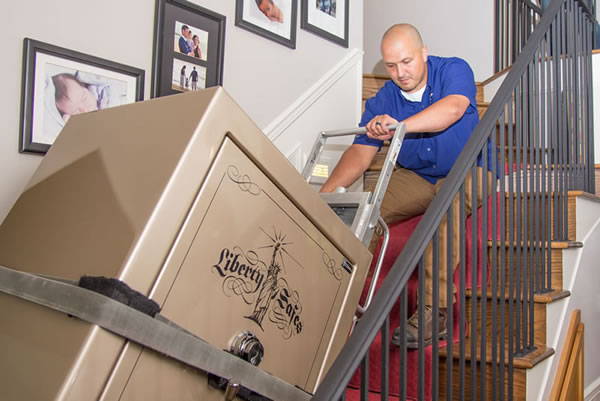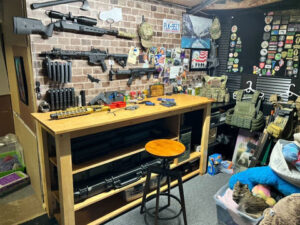To move a gun safe down stairs, use a sturdy dolly and enlist strong helpers. Ensure the path is clear and descend slowly, focusing on balance and safety.
Moving a gun safe down a flight of stairs is not a task to be taken lightly. It requires meticulous planning, precise execution, and an unwavering emphasis on safety. A heavy, bulky gun safe poses a risk to both the movers and the property, making it imperative to approach the process with caution.
Choosing the right equipment, such as a high-capacity dolly, and recruiting a team of able-bodied individuals are critical steps. Preparing the stairway by clearing obstructions and protecting surfaces can prevent accidents and damage. By taking these precautions, you create a controlled environment that minimizes hazards and ensures the safe’s secure relocation.
Safety First: Preparing To Move A Gun Safe Downstairs
Moving a gun safe downstairs isn’t just about muscle power. It demands a clear plan to ensure safety and avoid damage. Here’s how to prepare for this challenging task.
Assessing The Weight And Size Of Your Gun Safe
Before anything else, work out the details of your gun safe. The weight and size dictate the complexity of the move. Measure the dimensions: height, width, and depth. Understand the weight capacity by checking the manufacturer’s specifications. This information helps in choosing the right equipment.
| Dimension | Measurement |
|---|---|
| Height | [Enter Height] |
| Width | [Enter Width] |
| Depth | [Enter Depth] |
| Weight | [Enter Weight] |
Note down these numbers. They will guide you in the next steps.
Gathering The Right Tools And Equipment
The proper tools are crucial for safe transportation. Gather heavy-duty items such as:
- High-capacity dolly – make sure it’s rated for your safe’s weight.
- Stair-climbing equipment – it helps with handling weight on stairs.
- Furniture straps – for a secure grip.
- Moving blankets – to prevent scratches and damage.
- Gloves – for a safe and firm grasp.
- Non-slip shoes – to avoid accidents.
With these at hand, you’re ready to move a gun safe with confidence. Remember, never rush. Plan every step, communicate with your team, and proceed with caution.
Team Coordination: Who Should Help?
Team Coordination: Who should help with moving a gun safe downstairs? This task is not for everyone. You need strong individuals who can communicate well and work as a team. It’s crucial to pick the right people for a smooth and safe move.
Selecting Your Moving Team
- Assess the Weight: Know your gun safe’s weight to determine the number of helpers needed.
- Seek Physical Strength: Choose team members who have the physical capabilities to handle heavy lifting.
- Consider Experience: If possible, include people who have moving experience, especially with heavy items.
- Trust is Key: Select individuals you trust with the responsibility of handling your valuable safe.
Assigning Roles And Communicating Plans
Once you’ve assembled your team, it’s time to lay out the plans. Clear communication is vital.
- Leader: Choose one team member to lead and direct the moving process.
- Spotters: Assign at least two spotters. Their job is to look out for obstacles and ensure safety.
- Carriers: The rest are carriers who lift and carry the gun safe in sync.
Discuss the entire process step by step. Use clear, simple language so everyone understands the plan.
Now, make sure the path is clear. Remove any potential trip hazards. Each member should wear proper gear like gloves and supportive footwear. Remember, safety comes first when moving a heavy and bulky item like a gun safe downstairs.
Protective Measures: Securing The Gun Safe
Moving a heavy object like a gun safe down the stairs is no easy feat. The primary focus must be on safety—both for the individuals involved and the safe itself. Properly securing the gun safe is critical before attempting to move it. This ensures that the contents remain intact and the safe does not suffer damage. The following steps outline the necessary protective measures for a smooth moving process.
Locking The Safe And Removing Contents
Before wrapping and moving, you must lock the safe. A locked safe prevents doors from swinging open. It’s safer and easier to handle. Next, remove all the contents. This strategy reduces weight and prevents damage to items inside. Use the following checklist:
- Ensure the safe is fully locked.
- Take out all guns, ammunition, and valuables.
- Place items in a secure and separate area.
Wrapping The Safe For Protection
To protect the safe’s exterior, wrapping is essential. It keeps scratches, dents, and damage at bay. Follow these steps:
- Use thick blankets or moving pads to cover the safe.
- Secure the blankets with moving straps or heavy-duty tape.
- Ensure the safe’s edges are well-padded.
This approach minimizes risks during the move. It’s crucial for keeping both the safe and your home intact.

Credit: www.be-safe.org
Strategic Maneuvering: Navigating Stairs
Moving a gun safe down stairs requires precision. Heavy and bulky, these safes demand careful handling. Achieving this task is a blend of the right angle of approach and balancing technique. Let’s explore these methodical steps to ensure a safe descent.
Approaching Angles And The Balance Point
Finding the balance point is vital. It is the spot where the safe is most stable. This spot helps in reducing strain. It aids in maintaining control during the move. Approach the top of the stairs with the safe upright. The safe should lean slightly back toward the movers. This tilt helps in maneuvering around corners and through landings.
- Empty the safe: Less weight means less risk of injury.
- Measure staircases and safe: Check for obstacle-free routes.
- Protect your safe and stairs: Use blankets and padding.
- Team up: Gather strong friends or hire professionals.
- Equipment ready: Use a dolly, straps, and stair climbing tools.
Step-by-step Descent Techniques
The step-by-step descent focuses on steady, controlled movement. Keep the safe’s weight balanced between helpers.
- Position the dolly:
- At the safe’s balance point
- Secure the safe to the dolly with straps
- Team positions:
- One person at the bottom to guide
- Others at the top to push and balance
- Begin the descent:
- Move in unison, slow and steady
- Communicate throughout the process
- Gauge each step:
- Pause as needed
- Adjust grip and footing
- At the bottom:
- Carefully tip safe off the dolly
- Ensure safe placement
Moving the gun safe requires patience and planning. Safeguard your property and avoid injuries with structured strategies. Secure the safe’s bottom for unexpected shifts. Always wear gloves and supportive footwear. Above all, never rush the process.
After The Move: Re-securing And Maintenance
Following a successful move of your gun safe downstairs, it’s paramount to ensure that your security investment is both undamaged and properly maintained. This next stage focuses on two key aspects: examining the safe for any potential damages from the move, and finding the ideal location and anchoring method to minimize risks. Let’s delve into how to tackle these tasks effectively.
Checking For Damages And Functionality
Once your gun safe is downstairs, start with a thorough inspection. Carefully check for:
- External Damage: Scratches or dents that may have occurred during the move.
- Door Integrity: Make sure it opens and closes smoothly.
- Lock Mechanism: Verify that it locks and unlocks as expected.
- Internal Components: Check for any dislodged shelves or supports.
If you notice any issues, contact a professional for advice or repair.
Tips For Gun Safe Placement And Anchoring
Choosing the right spot and securing your gun safe is critical. Consider these tips:
| Placement Tips | Anchoring Tips |
|---|---|
| Find a low-traffic area to deter tampering. | Use heavy-duty bolts for concrete or wood surfaces. |
| Ensure the location is free from humidity to prevent corrosion. | Anchor to floor joists if placing on a wooden floor. |
| Avoid placing directly against walls to reduce pry leverage. | Double-check stability after anchoring. |
Regular maintenance is crucial for lasting safety and security. Perform periodic checks and cleanings. Oil the lock mechanism, check the battery in electronic keypads, and ensure that the safe is bolted securely. Such diligence will keep your valuables protected for years to come.

Credit: www.libertysafe.com
Credit: www.libertysafe.com
Frequently Asked Questions On How To Move A Gun Safe Down Stairs
Can You Move A Gun Safe With A Dolly?
Yes, you can move a gun safe with a dolly. Ensure it’s heavy-duty, secure the safe properly, and use caution when navigating.
Should Gun Safe Be Upstairs Or Downstairs?
Place your gun safe downstairs for easier access during emergencies and to support its heavy weight. Upstairs installation is viable with reinforced flooring.
Can You Lay A Gun Safe Down To Move It?
Yes, you can lay a gun safe down to move it, but ensure it’s secured to prevent damage. Employ padding to protect the finish and avoid jostling internal components. Always move with care and seek professional assistance if necessary.
Will My Floor Hold A 1000 Lb Safe?
To ensure your floor can support a 1000 lb safe, consult a structural engineer or check building codes for load-bearing capacities. Many modern homes can sustain this weight if properly distributed.
Conclusion
Moving a gun safe downstairs requires preparation, precision, and safety. Embrace these tips to ensure a smooth transition. Partner with friends or professionals, stay patient, and prioritize protection. Your success is one careful step away. Secure transport today for peace of mind tomorrow.
Stay safe and tread lightly.


